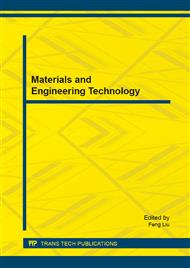[1]
Wang Hong-jun, Miao Xiu-mei, Men Jin-zhu, Research on the blanket effective area model of active jammer fixed in the missile aimed to shipborne radar, Ship Science and Technology, Vol. 34, No. 10, pp.85-88, Oct. (2012).
DOI: 10.4028/www.scientific.net/amr.588-589.2097
Google Scholar
[2]
Luo Bo, Bi Yi-ming, Li Ma-shu, Simulation evaluation for combat efficiency of jammer fixed in missile, Ordance Industry Automation, Vol. 29, No. 12, pp.28-30, Dec. (2010).
Google Scholar
[3]
Chang Lei, Wang Huan-qiang, Wang Xian-peng, Qu Tao, Penetration evaluation of jammer fixed in missile, Electronic Information Warfare Technology, Vol. 26, No. 5, pp.69-71, Sep. (2011).
Google Scholar
[4]
Wang Li-guang, Jing Zhan-rong, Analysis and simulation for performance of jammer fixed in cruise missile, Journal of System Simulation, Vol. 20, No. 14, pp.3846-3852, Jul. (2008).
Google Scholar
[5]
Zhao Guo-qing, Principle of Radar Lountermeasure (the Second editor), Xi Dian University Press, pp.198-200, Oct. (2012).
Google Scholar
[6]
D. Adamy, EW101: A First Course in Electronic Warfare & EW102: A Second Course in Electronic Warfare, Publishing House of Electronics Industry, Sep. (2011).
Google Scholar
[7]
A. Sergei, Lev. Shustov, H. Robert, Fundamentals of Electronic Warfare, Publishing House of Electronics Industry, May (2004).
Google Scholar
[8]
Fan Ying-biao, Yao Yao-ting, Analysis and simulaiton on continuous fire frequency of coordinate air defense in warship formation, Computer Engineering and Design, Vol. 32, No. 6, pp.2092-2095, (2011).
Google Scholar
[9]
Zhao Jian-jun, Wang Yi, Firing time of warshipformation in coordination air defense, Ordance Industry Automation, Vol. 31, No. 9, pp.15-18, Sep. (2012).
Google Scholar
[10]
Cheng Si-yi, Song Hai-fang, Research on airborne self-protection jamming efficiency estimation model in penetration process, Electronic Warfare, No. 5, pp.33-36, 201.
Google Scholar


